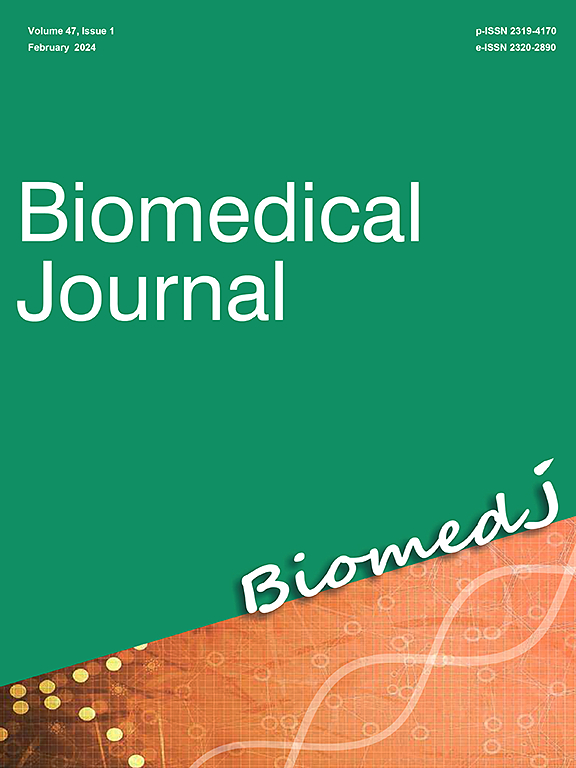线粒体疾病分子诊断平台的建立:从传统测序到新一代测序。
IF 4.1
3区 医学
Q2 BIOCHEMISTRY & MOLECULAR BIOLOGY
引用次数: 0
摘要
研究背景本研究旨在创建一个分子诊断平台,并为高度怀疑患有线粒体疾病的患者建立诊断管道。研究将比较三种方法,即传统的限制性片段长度多态性聚合酶链反应(RFLP-PCR)、用于热点检测和全线粒体DNA(mtDNA)的桑格测序法以及第三代(Nanopore)全线粒体DNA测序法,在诊断疑似原发性线粒体疾病(PMDs)患者方面的有效性。材料和方法:为了验证疑似线粒体疾病的诊断方法,我们进行了一项单中心前瞻性队列研究。在第一阶段,采用五组引物的 PCR 方法,利用 RFLP 或直接 Sanger 测序筛选八个热点(m.3243A>G、m.3460G>A、m.8344A>G、m.8993T>G、m.9185T>C、m.11778G>A、m.13513G>A 和 m.4977deletion)。Sanger 测序也用于确认 RFLP 阳性样本。在第二阶段,对于八个热点筛选结果呈阴性的样本,采用桑格测序法或第三代纳米孔测序法进行线粒体全基因组测序:结果:2020 年 6 月至 2023 年 5 月期间,30 名临床疑似线粒体疾病的 0 至 63 岁患者入组。PMD诊断的阳性率为8/30=26.7%,基于RFLP方法的异体水平灵敏度约为5%。第一阶段检测结果为阴性的其余22名患者使用桑格测序法或第三代测序法Nanopore进行检测,结果显示所有患者的病理mtDNA突变均为阴性。与桑格测序法相比,RFLP-PCR 的结果受到 RFLP 酶消化不完全的限制。对于mtDNA的全基因组测序,我们机构更倾向于使用桑格测序法,而不是纳米孔测序法,因为它具有成本效益:在我们的高选择性队列中,大多数人在 8 个热点筛查的第一阶段检测中呈阳性。桑格测序是线粒体疾病筛查的一种传统而准确的方法,至少对该地区最常见的热点来说是如此。结果表明,桑格测序是一种准确的方法,而且成本效益更高。这一完整的分子诊断平台具有成本相对较低、报告时间较短的优点,有助于对有临床证据表明患有此类疾病的患者进行重要的鉴定。该诊断流程图也已被转化为三级医院的常规临床应用。本文章由计算机程序翻译,如有差异,请以英文原文为准。
The establishment of a molecular diagnostic platform for mitochondrial diseases: From conventional to next-generation sequencing
Background
The aim of this study was to create a molecular diagnostic platform and establish a diagnostic pipeline for patients highly suspected of mitochondrial disorders. The effectiveness of three methods, namely, traditional restriction fragment length polymorphism-polymerase chain reaction (RFLP-PCR), Sanger sequencing for hotspot detection and whole mitochondrial DNA (mtDNA), and third-generation (Nanopore) whole mtDNA sequencing, will be compared in diagnosing patients with suspected primary mitochondrial diseases (PMDs). The strengths and limitations of different methods are also discussed.
Material and methods
A single-center prospective cohort study was conducted to validate the diagnostic pipeline for suspected mitochondrial diseases. In the first stage, a PCR-based method with five sets of primers was used to screen for eight hotspots (m.3243A > G, m.3460G > A, m.8344A > G, m.8993T > G, m.9185T > C, m.11778G > A, m.13513G > A, and m.4977deletion) using either RFLP or direct Sanger sequencing. Sanger sequencing was also used to confirm the RFLP-positive samples. In the second stage, for samples with negative screening results for the eight hotspots, mitochondrial whole-genome sequencing was performed using Sanger sequencing or third-generation nanopore sequencing.
Results
Between June 2020 and May 2023, 30 patients from ages 0 to 63 with clinically suspected mitochondrial disease were enrolled. The positive yield for the diagnosis of PMDs was 8/30 = 26.7%, and the sensitivity of the heteroplasmy level for the RFLP-based method was approximately 5%. The remaining 22 patients who tested negative at the first stage were tested using Sanger sequencing or the third-generation sequencing Nanopore, and all tested negative for pathological mtDNA mutations. Compared to the Sanger sequencing method, the results of RFLP-PCR were compromised by the limitations of incomplete RFLP enzyme digestion. For whole-genome sequencing of mtDNA, Sanger sequencing, instead of nanopore sequencing, is preferred at our institution because of its cost-effectiveness.
Conclusions
In our highly selective cohort, most tested positive in the first stage of the 8 hot spots screen. Sanger sequencing is a conventional and accurate method for mitochondrial disease screening, at least for the most common hot spots in the region. The results revealed that Sanger sequencing is an accurate method with the benefit of being more cost-effective. This integral platform of molecular diagnosis bears the advantages of being relatively low cost and having a shorter reporting time, facilitating crucial identification of patients with clinical evidence of such disorders. This diagnostic flowchart has also been translated into routine clinical use in the tertiary hospital.
求助全文
通过发布文献求助,成功后即可免费获取论文全文。
去求助
来源期刊

Biomedical Journal
Medicine-General Medicine
CiteScore
11.60
自引率
1.80%
发文量
128
审稿时长
42 days
期刊介绍:
Biomedical Journal publishes 6 peer-reviewed issues per year in all fields of clinical and biomedical sciences for an internationally diverse authorship. Unlike most open access journals, which are free to readers but not authors, Biomedical Journal does not charge for subscription, submission, processing or publication of manuscripts, nor for color reproduction of photographs.
Clinical studies, accounts of clinical trials, biomarker studies, and characterization of human pathogens are within the scope of the journal, as well as basic studies in model species such as Escherichia coli, Caenorhabditis elegans, Drosophila melanogaster, and Mus musculus revealing the function of molecules, cells, and tissues relevant for human health. However, articles on other species can be published if they contribute to our understanding of basic mechanisms of biology.
A highly-cited international editorial board assures timely publication of manuscripts. Reviews on recent progress in biomedical sciences are commissioned by the editors.
 求助内容:
求助内容: 应助结果提醒方式:
应助结果提醒方式:


